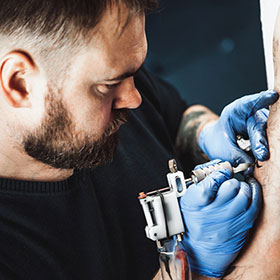Yes, a scar can often be tattooed over. Many people choose to cover scars with tattoos to improve their appearance.
Scars can hold memories, both good and bad. Sometimes, they are reminders of events we’d rather forget. Tattooing over scars can help transform these marks into beautiful art. It is important to know that not all scars are the same.
Some may take tattoos well, while others might be a bit challenging. Factors like the type, age, and location of the scar play a role. Consulting a skilled tattoo artist is key. They can advise if your scar is suitable for tattooing. In this blog, we’ll explore everything you need to know about covering scars with tattoos.
Types Of Scars
Keloid scars are raised and thick. They grow beyond the original wound. These scars can be red or dark. Keloid scars are harder to tattoo over. The thick skin makes it difficult. Tattoo ink might not stay well.
Hypertrophic scars are also raised. They stay within the wound area. These scars may be red or pink. Tattooing over hypertrophic scars is easier. The skin is not as thick as keloid scars. Ink can stay better in these scars.
Atrophic scars are sunken. They form when the skin does not heal properly. Examples include acne scars and stretch marks. Tattooing over atrophic scars is possible. The skin is thin but can hold ink. It may take more care and skill.
Tattooing Over Scars: Feasibility
Scar tissue is different from normal skin. It can be thicker or thinner. The age of the scar matters. Fresh scars need time to heal. Old scars are better for tattooing. The color of the scar also plays a role. Lighter scars may need more ink.
Old scars are easier to tattoo. Scars at least one year old are best. The scar must be flat. Raised scars are harder to work with. The area around the scar should be healthy. No redness or swelling.
Raised scars are difficult. Keloid scars are a big problem. They can grow after the tattoo. Red or swollen scars are a no-go. Fresh scars are also not good. The skin needs time to heal.
Preparation Tips
Tattooing over a scar is possible with careful planning. Consult an experienced artist to discuss design and placement. Proper aftercare ensures the best results.
Consulting A Professional
A professional tattoo artist can give you the best advice. They will check your scar and see if it can be tattooed over. It is important to talk about your expectations. The artist will explain what can be done. This will help you avoid disappointment later.
Choosing The Right Design
The right design can cover the scar well. Some designs work better than others. Your artist can suggest good options. Make sure the design fits the scar shape. This helps in hiding it better.
Skin Preparation Steps
Clean your skin before getting a tattoo. This helps prevent infections. Use a mild soap and water. Pat the area dry with a clean towel. Do not use lotions or oils. They can affect the tattoo ink. Also, avoid sun exposure. Sunburned skin is not good for tattoos.
Tattooing Process
The tattoo artist first examines the scar. They check its age and texture. Next, they clean the area. This step is very important. Then, the artist applies a stencil. This shows the tattoo design. Finally, they start tattooing. This can take some time. Careful work is needed for good results.
Tattooing over a scar can be painful. The skin is sensitive. The artist might use numbing cream. This helps reduce pain. Deep breaths can also help. Some people find distraction useful. Listening to music or chatting can help.
The tattoo will need time to heal. This can take several weeks. Follow the care instructions given by your artist. Keeping the area clean is key. Avoid scratching or picking at the tattoo. Moisturizing can help the skin heal faster. Patience is important during this time.
Potential Risks
Tattooing over a scar can lead to infections. The skin may not heal properly. Bacteria can enter through the skin. This can cause redness, swelling, and pain. In some cases, you might need antibiotics. Always go to a licensed tattoo artist.
Scars are sensitive and can react badly to tattoos. The skin might raise more. This can change the look of your tattoo. Some scars might bleed during the process. It’s important to talk to a professional.
Some people are allergic to tattoo inks. This is more likely if you have a scar. Allergic reactions can cause itching and swelling. In some cases, you might get a rash. Always do a patch test first.
Aftercare Tips
Keep the tattooed area clean and dry. Use a mild soap to wash it. Pat it gently with a clean towel. Avoid rubbing the area. Apply a thin layer of healing ointment. Cover it with a sterile bandage. Change the bandage daily. Avoid touching the tattoo with dirty hands. Keep it away from water for long periods. Avoid swimming pools and hot tubs. Stay out of direct sunlight.
Moisturize the tattoo regularly. Use a fragrance-free lotion. Wear loose clothing to avoid friction. Protect the tattoo from the sun. Use sunscreen with high SPF. Avoid soaking the tattoo in water. Do not scratch or pick at the scab. Let it heal naturally. Stay hydrated and maintain a healthy diet.
Watch for redness and swelling. Check for unusual pain or discomfort. Look out for pus or a foul smell. Note if there’s excessive itching. Be aware of fever or chills. Seek medical advice if symptoms worsen.
Expert Opinions
Dermatologists say tattooing over scars can be safe. It depends on the scar type and healing. Fresh scars should not be tattooed. Wait at least a year. Scar tissue is different. It can be thicker or raised. This can affect tattoo quality. Consult a dermatologist before deciding.
Tattoo artists often work on scars. Experience matters. Some artists specialize in scar cover-ups. They know how to work with different scars. Tattooing over scars is possible. Communication is key. Tell the artist about the scar history. Share any concerns. Choose a skilled artist for the best result.
Success Stories
Many wonder if tattoos can cover scars. Yes, skilled artists can work wonders. Transform scars into beautiful art.
Personal Experiences
Many people have shared their success stories. Tattoos helped them cover scars. Some felt happy after the tattoo. It gave them a new look. Confidence grew. Smiles returned.
Visual Transformations
Scar tattoos can change how scars look. Creative designs can hide the old marks. Some scars blend well with the art. Others get a new pattern. The change can be amazing.
Conclusion
Tattooing over a scar is possible and can be beautiful. It’s important to choose a skilled artist. Consult a professional before deciding. Each scar is unique, and results may vary. Proper care ensures better healing. Remember to consider your pain tolerance.
Research and patience are key. This decision is personal. Listen to your body and your heart. A tattoo can transform a scar into art. Make sure it feels right for you.

